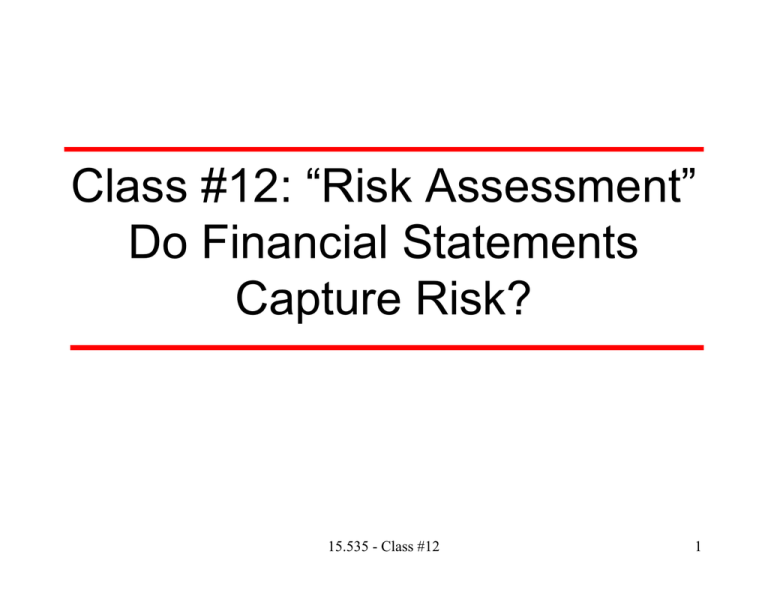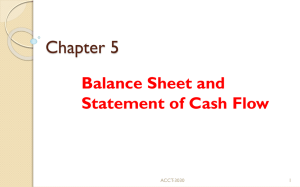Document 10324484
advertisement

Class #12: “Risk Assessment” Do Financial Statements Capture Risk? 15.535 - Class #12 1 Where Have We Been & Where Are We Going? • Team Projects – Part 1 of Projects posted on the web – Comments on projects and due dilgence – hand back after break – Part 2 – Valuation: Due May 9, 2003 • Quiz #1 – Solutions on class server – Comment on Re-grades – Quiz statistics 15.535 - Class #12 2 Where Have We Been & Where Are We Going? • Class 1 through Quiz #1 – Valuation Basics, Accounting-based Valuation, Multiples Analysis – Cash Flow Analysis, Refresher on Financial Statements – Detecting Accounting Manipulations – Part 1 of Project (Cash Flow Projections/Earnings Quality Analysis) • Class 12 through Quiz #2 – Risk Assessment (Credit), Cost of Capital Calculations – Risk and Analyzing Accounting Trading Strategies – Mergers and Acquisitions, Stock Options • Class 20 through Final Project Presentations – Off Balance Sheet Activities, Pension Plans, International Accounting and Valuation 15.535 - Class #12 3 Financial Statement Analysis – Risk Assessment • Common-Size Financial Statements (crosssectional analysis) – e.g. Deflate all financial numbers by total assets • Trend Financial Statements (time-series analysis) – Compare growth rates over time • Financial Ratio Analysis – Profitability ratios, short-term liquidity ratios, longterm solvency ratios 15.535 - Class #12 4 Accounts Receivable Turnover Measures how soon sales will be become cash: Accounts Receivable Turnover = Net Sales on Account Avg Accounts Receivable Perhaps a more intuitive measure of the rate at which A/R are being collected is the days receivable outstanding: Days Receivable Outstanding = 365 / Accounts Receivable Turnover 15.535 - Class #12 5 Inventory Turnover Ratio This ratio measures how quickly inventory is being sold. Inventory Turnover = Cost of Goods Sold Average Inventory Perhaps a more intuitive measure of the rate at which inventory is being sold is the days inventory held: Days Inventory Held = 365/Inventory turnover 15.535 - Class #12 6 Fixed Asset Turnover Measures the relation between sales and the investment in property, plant, and equipment. How efficiently is the firm using its fixed assets to generate sales? Fixed asset turnover = ___ Sales___ Average fixed assets 15.535 - Class #12 7 Accounts Payable Turnover Measures how quickly a firm is paying its suppliers. Accounts Payable Turnover = Purchases____ Average Accounts Payable Also can be expressed as: Days Payable Outstanding = 365 / (Accounts Payable Turnover Rate) 15.535 - Class #12 8 Analysis of Short-Term Liquidity • Sheds light on a firm’s ability to pay for obligations that come due during its operating cycle (e.g., wages, purchases of inventory). • Commonly used measures of short-term debt paying ability include: – Current Ratio – Quick Ratio – Operating Cash Flow to Current Liabilities Ratio 15.535 - Class #12 9 Current Ratio Current Ratio = Current Assets Current Liabilities • This ratio matches the amount of cash and other current assets that will become cash within one year against the obligations that come due in the next year. • Basic rule of thumb: A minimum current ratio of 1.0. 15.535 - Class #12 10 Quick Ratio A variation of the current ratio is the quick ratio or acid test ratio. Quick Ratio = Cash + Mkt Securities + AR = CA-Inv Current Liabilities CL Include in the numerator only those current assets that the firm could convert quickly into cash 15.535 - Class #12 11 Operating Cash Flow to Current Liabilities Ratio • Another measure a firm’s short-term liquidity. – The advantage is that it is based on cash flow AFTER the funding needs for working capital (i.e., accounts receivables and inventory) been made. Operating Cash Flow Average Current Liabilities 15.535 - Class #12 12 Long-Term Solvency Ratios • Measure a firm’s ability to meet interest and principal payments on long-term debt (and similar obligations, like long-term leases) when they come due. • Obviously, the best indicator for assessing long-term solvency risk is a firm's ability to generate earnings over a period of years. 15.535 - Class #12 13 Long-Term Solvency Ratios Long-Term Debt Ratio = Debt/Equity Ratio = Long-Term Debt Long-Term Debt + Shareholders’ Equity Long-Term Debt Shareholders’ Equity Liabilities/Assets = Ratio 15.535 - Class #12 Total Liabilities Total Assets 14 Interest Coverage Ratio Measures how many times a firm's net income before interest expense and income taxes exceeds its interest expense. Net Income + Interest Expense + Income Tax Expense + Minority Interest in Earnings Interest Expense Interest coverage ratios less than 2.0 suggest a risky situation. 15.535 - Class #12 15 Cash Interest Coverage Ratio • Interest coverage ratio using cash flows is: [Cash Flow from Operations + Cash Payments for Interest + Cash Payments for Income Taxes] Cash Payments for Interest 15.535 - Class #12 16 Accounting, Risk and Hedging: What is hedging? • What is hedging? – In response to financial market risks, companies engage in hedging: business and financial transactions designed to insulate them from commodity price, interest rate, exchange rate, or other risks. Derivative securities are often used to accomplish this insulation. • Different from speculation: How? • Examples: – Options, futures contracts, swaps, other complex combinations of derivatives. 15.535 - Class #12 17 Why do firms hedge? • The value of equity claims in the firm are: • Price = E(CF1)/(1+r) + E(CF2)/(1+r)2 + …. • How can we increase firm value? – The equity cost of capital (=r) depends on the systematic risk of the firm’s cash flows. – Insurable or hedgeable risks are generally nonsystematic – Since insurance purchases apparently do not affect a firm’s systematic risk, then they should not change the firm’s cost of capital. – If insurance purchases affect firm value, then they must change future expected cash flows! 15.535 - Class #12 18 Hedging and the Modigliani-Miller Theorem • If hedging affects current firm value, then it must: 1) 2) 3) 15.535 - Class #12 19 How Hedging Impacts Firm Value • Taxes: – A progressive tax scheme (or, at a minimum, incomplete “tax refunds” of losses) means that the more volatile a firm’s taxable income, the higher its expected taxes. (See notes from last day) • Contracting Costs: – Stockholders, employees, bondholders, suppliers and customers all have high incentives to avoid financial distress. Why? • Customers: Product warranties & long-term service arrangements • Suppliers: Undiversified – locked in to single client 15.535 - Class #12 20 Hedging and the Firm’s Employees • Employees (from the CEO down to temp workers) face real costs to financial distress • If the firm is risky, employees require higher compensation (risk aversion) • Executive incentive compensation should only impose “risk” on managers if they have control over the outcomes. – Maybe managers are hedging too much? 15.535 - Class #12 21 Hedging and Bondholder-Shareholder Conflict • The agency costs of debt increase as leverage increases and financial distress approaches – Remember: stockholders and managers are self-intereseted – Therefore, we get:the: • • • • Dividend payout problem Claim dilution problem Asset substitution problem Underinvestment problem • Hedging can reduce the likelihood of financial distress, and consequently reduce the agency problems of debt … This means firms can have easier access to the debt markets. • What does this mean for future expected cash flows? 15.535 - Class #12 22 Summary of Risk Assessment using Financial Informtion • Analysis of a particular firm's financial ratios over a period of years allows one to track historical trends and variability in the ratios over time. • Key is compare with industry benchmarks. • An important part of the analyst's job is to use financial ratios to identify aspects of the firm that warrant deeper investigation. 15.535 - Class #12 23 Where Next? • Readings Related to Today’s Class: – “Risk Analysis” – pages 145-159 of Section (F) of Course Reader (“Introduction to Profitability and Risk Analysis”) • Reading for Next Class after the break (Tuesday, April 1) – Cost of Capital Calculations – Skim over cost of capital issues in Section (C) of Course Reader (“Firm Valuation: Cost of Capital”) 15.535 - Class #12 24






